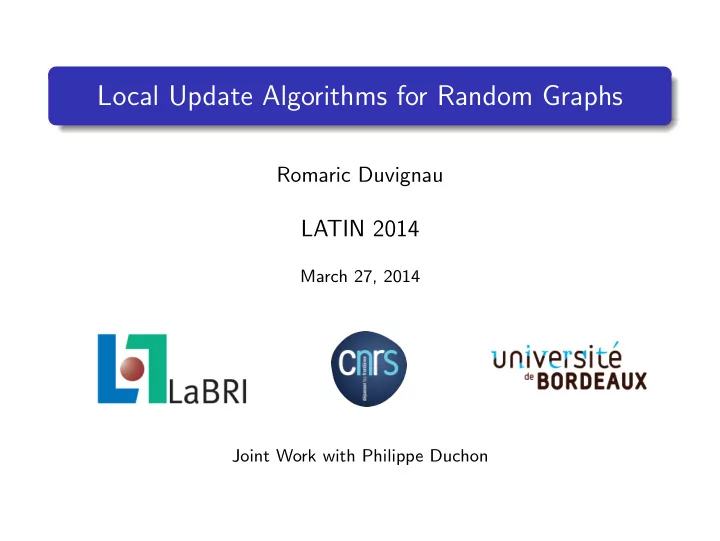

Local Update Algorithms for Random Graphs Romaric Duvignau LATIN 2014 March 27, 2014 Joint Work with Philippe Duchon
Introduction Context Peer-to-Peer Networks (modelled as graphs) Structure dependent on the update sequence Potential malicious sequence of updates Difficulty in designing/analysing update algorithms Analysis under nicely behaving update schemes Romaric Duvignau Local Update Algorithms for Random Graphs 1 / 7
Introduction Context Peer-to-Peer Networks (modelled as graphs) Structure dependent on the update sequence Potential malicious sequence of updates Difficulty in designing/analysing update algorithms Analysis under nicely behaving update schemes Proposition: distribution-preserving update algorithms Maintain exactly a probability distribution of random graphs No probabilistic model for the update sequence Romaric Duvignau Local Update Algorithms for Random Graphs 1 / 7
Distribution preserving algorithms Definition For each possible vertex set V , G should follow a given target distribution µ V , which is preserved through updates : Insertion : If G ∼ µ V and u �∈ V then I ( G , u ) ∼ µ V ∪{ u } Deletion : If G ∼ µ V and u ∈ V then D ( G , u ) ∼ µ V \{ u } Romaric Duvignau Local Update Algorithms for Random Graphs 2 / 7
Distribution preserving algorithms Definition For each possible vertex set V , G should follow a given target distribution µ V , which is preserved through updates : Insertion : If G ∼ µ V and u �∈ V then I ( G , u ) ∼ µ V ∪{ u } Deletion : If G ∼ µ V and u ∈ V then D ( G , u ) ∼ µ V \{ u } Uniform k -out graphs Simple digraphs with out-degree k Uniform distribution: Each outgoing neighbourhood N + ( v ) is uniform among the k -subsets of V − v The N + ( v ) are mutually independent Romaric Duvignau Local Update Algorithms for Random Graphs 2 / 7
A local model Local update model No global knowledge Knowledge of the current size Ability to pick a uniform random vertex RandomVertex() Ability to examine neighbours of a given node Romaric Duvignau Local Update Algorithms for Random Graphs 3 / 7
A local model Local update model No global knowledge Knowledge of the current size Ability to pick a uniform random vertex RandomVertex() Ability to examine neighbours of a given node RandomVertex() Substitute for “contact a friend node” Uniformity : strong assumption Similar external mechanisms in the literature Very costly Romaric Duvignau Local Update Algorithms for Random Graphs 3 / 7
A local model Local update model No global knowledge Knowledge of the current size Ability to pick a uniform random vertex RandomVertex() Ability to examine neighbours of a given node RandomVertex() Substitute for “contact a friend node” Uniformity : strong assumption Similar external mechanisms in the literature Very costly We measure the cost of our algorithms essentially as the expected number of calls to RandomVertex() . Romaric Duvignau Local Update Algorithms for Random Graphs 3 / 7
Our results Preservation of uniform k -out graphs Several insertion and deletion algorithms Our best algorithms: Deletion : calls o (1) times RandomVertex() Insertion : calls asymptotically k times RandomVertex() Romaric Duvignau Local Update Algorithms for Random Graphs 4 / 7
Our results Preservation of uniform k -out graphs Several insertion and deletion algorithms Our best algorithms: Deletion : calls o (1) times RandomVertex() Insertion : calls asymptotically k times RandomVertex() These asymptotic bounds are optimal. Romaric Duvignau Local Update Algorithms for Random Graphs 4 / 7
Deletion Algorithms Deletion of vertex 2 2 1 0 5 4 3 Vertex 2 wants to leave the network. Romaric Duvignau Local Update Algorithms for Random Graphs 5 / 7
Deletion Algorithms Deletion of vertex 2 2 1 0 5 4 3 Vertex 2 leaves the network, and there are 3 loose edges. Romaric Duvignau Local Update Algorithms for Random Graphs 5 / 7
Deletion Algorithms Deletion of vertex 2 RV 2 1 RV 0 5 RV 4 3 Vertices 0, 4 and 5 replace 2 using RandomVertex() . We need k calls on average. Romaric Duvignau Local Update Algorithms for Random Graphs 5 / 7
Deletion Algorithms Deletion of vertex 2 2 1 0 5 4 3 Deletion of vertex u Simple algorithm needs k calls to RandomVertex() Better algorithm: re-using u ’s successors o (1)-algorithm: re-using u ’s predecessors Romaric Duvignau Local Update Algorithms for Random Graphs 5 / 7
Insertion Algorithms Insertion of vertex 5 2 1 0 5 4 3 Vertex 5 wants to join the network. Romaric Duvignau Local Update Algorithms for Random Graphs 6 / 7
Insertion Algorithms Insertion of vertex 5 RV 2 1 0 5 4 3 RV Vertex 5 chooses 2 distinct vertices as successors, using RandomVertex() . Romaric Duvignau Local Update Algorithms for Random Graphs 6 / 7
Insertion Algorithms Insertion of vertex 5 2 1 0 5 4 3 Vertex 5 chooses X ∼ Binomial( n , k / n ) distinct random vertices as predecessors, and steals one edge from each of them. We need k calls in expectation to chose the predecessors. Romaric Duvignau Local Update Algorithms for Random Graphs 6 / 7
Insertion Algorithms Insertion of vertex 5 2 1 0 5 4 3 Insertion of vertex u Simple insertion needs, on average, 2 k calls to RandomVertex() k -insertion: re-use the deleted edges Romaric Duvignau Local Update Algorithms for Random Graphs 6 / 7
Conclusion Results Precise definition of distribution-preserving algorithms Uniform k -out graphs: asymptotically optimal algorithms Further research Uniform undirected k -regular graphs Distribution depending on the “identities” of the nodes: e.g. geometric graphs Romaric Duvignau Local Update Algorithms for Random Graphs 7 / 7
Thank you Thank you for your attention. Romaric Duvignau Local Update Algorithms for Random Graphs 7 / 7
Recommend
More recommend